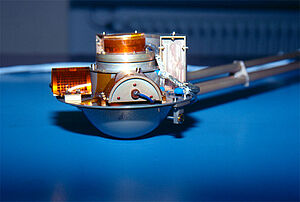ROMAP

ROMAP (Rosetta Lander Magnetometer and Plasma Monitor) is a multi-sensor instrument on the lander unit Philae. It measures both the magnetic field and the ions and electrons. The sensors are located on a 60 cm boom, which was expanded during the landing phase. Operating this instrument on the surface of a comet called for the development of a new kind of digital magnetometer of low-mass and low power demands. For the first time, a magnetometer was operated inside a plasma sensor.
ROMAP was developed under the lead of the TU Braunschweig. IWF delivered the control unit and the flight software. The demands regarding the necessary resources (weight <60 g, power <170 mW) were a great challenge. On the surface of the comet, the magnetometer was exposed to extreme temperatures. Calibration of the magnetometer over a wide range of temperatures was performed in a special facility developed by IWF. Because of the short boom and the stray magnetic fields from the electromotors on the lander unit, a special magnetic cleanliness program was necessary for which IWF developed the software and analyzed the data.
Thanks to the close proximity of Rosetta to the comet and the measurements of the lander unit Philae on the surface, the first detailed investigations on the magnetic properties of a cometary nucleus could be performed. The orbiter magnetometer RPC-MAG and ROMAP discovered that the comet does not have an intrinsic magnetic field.
More information about ROMAP can be found at TU Braunschweig.